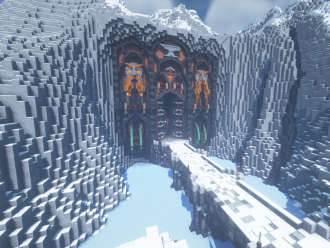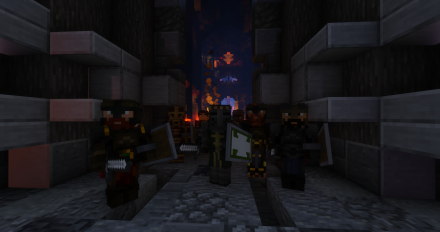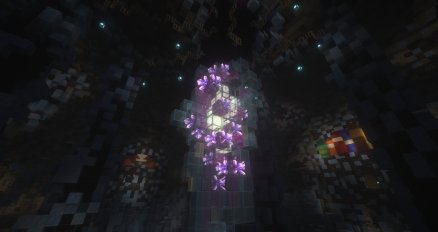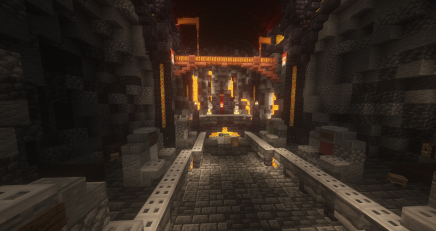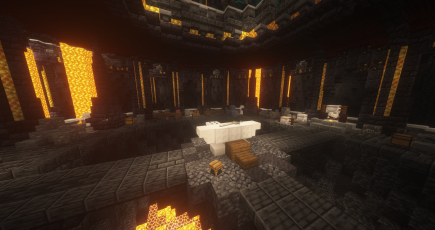Dar-Ach Denur
| Location | Drzathas Mountains |
| Country | Kalan Confederation of Arduan |
| Founded | Founded in 50 by Arduan Starforge |
| Governing Body | Council of the Great Kalans |
| Races | Denur |
| Language(s) | Common, Denurûm |
| Primary Religions | The Attarsal - Traditional Spirit Beliefs |
Dar-Ach Denur
Nestled high in the towering Drzathas Mountains, Dar-Ach Denur, which can be translated as "Our Home of the Denur," stands as a symbol of unity and tradition for all Denur. It served as the capital of the Kalan Confederation of Arduan and was once the seat of the Harrikum, the ancient rulers of the Denur people. Dar-Ach Denur isn't just the political hub; it's also a spiritual hotspot, drawing Denur pilgrims from everywhere. The place is alive with old beliefs and the strong customs that unite the Denur folks making it the heart and soul of their culture.
Unlike other great fortresses of the Denur, Dar-Ach Denur is claimed by none of the major Kalans. It is considered a neutral ground, officially known as The Freehold, where no single Kalan has jurisdiction or claims of authority. The fortress stands as a sanctuary for all Denur, regardless of their allegiances, ensuring that Dar-Ach remains a place of unity rather than division. Within its sacred halls, disputes between the Kalans are strictly forbidden, and any attempt to exert political influence is met with disdain. Only peace, respect, and cooperation are welcome in the spiritual heart of the Denur people.
However, the Denur are passionate folk, and the occasional scuffle or brawl is not entirely absent. Minor quarrels, often resolved with a hearty brawl in one of Dar-Ach’s many lively taverns, are seen as a harmless way to blow off steam, provided they remain within bounds. These brief flare-ups of temper are treated as moments of levity rather than serious disputes, and they serve as a reminder that while Dar-Ach is a place of peace, the fiery spirit of the Denur is never far from the surface.
Dar-Ach Denur has this special vibe. It's the go-to spot where any Denur, no matter their Kalan, can kick back and feel all high and mighty together as one big family 'cause of all the stuff they've been through and their tight-knit beliefs.
Founding
Current records indicate that the first Harrikum, Arduan Starforge, who brought the dispersed Denur clans together under one roof, formally established Dar-Ach Denur in the year 50. During a period of intense unrest and invasion by the hostile kingdoms that encircled the Denur, Dar-Ach was founded out of necessity. Arduan thought that his people's survival and unity depended on having a powerful, central keep. Dar-Ach, perched high in the unyielding Drzathas Mountains, became not just a fortress but a symbol of hope and strength for the Denur.
The story goes that Arduan himself forged the cornerstone of Dar-Ach, using the legendary Starforged Greataxe said to have been gifted by Kor, striking the earth with such force that it created an unbreakable foundation. It was this foundation that helped Dar-Ach withstand centuries of siege and hardship. The fortress grew rapidly, and under Arduan's guidance, it became the spiritual and political heart of the Denur, where the Kalans met to resolve disputes and rally in times of need.
Recent findings, however, have provided fresh insight into Dar-Ach Denur's beginnings. The roots of the stronghold may go much beyond Arduan's period, according to the recently discovered ancient relic known as the Monilight of Dar-Ach Denur. Some academics think that long before Arduan, a person by the name of Deonach the Golden might have established an early structure on the location. It is believed that Arduan enlarged and changed this previous settlement into the imposing fortress that it is today, while the specifics are still unknown.
Despite these new theories, Arduan Starforge is still credited as the true founder of Dar-Ach Denur, the one who gave it its enduring purpose. His vision of a united Denur people, shielded by the mountain fortress, has stood the test of time, making Dar-Ach not only a place of refuge but a beacon of hope for all Denur.
Historic Events
The once-mighty halls of Dar-Ach Denur have witnessed countless pivotal moments in Denur's history, but not without great cost. The last two devastating sieges of Dar-Ach left much of its vast archives in ruin. Centuries of recorded history - detailing local events, ancient battles, and cultural milestones - were reduced to ashes. Only fragments of the most recent records survived, allowing the Denur to piece together their more immediate past.
The Sealing of Dar-Ach (1507)
The Denur made the disastrous choice to isolate themselves from the outside world in 1507 as the terrible Rotting Plague ravaged the country. The fiercely pragmatic Harrikum Uldrig Proudfist ordered that each Kalan and fortress be left to its own way. His calculating, chilly attitude destroyed the Denur's long-held ideals of solidarity and support for one another. It was perceived by many as a betrayal of their old honor. Uldrig made the audacious and contentious decision to seal Dar-Ach Denur's enormous gates, keeping out the plague and those who were fleeing for their lives. His idea seemed to work at first. However, there was a price for this seeming triumph. The once unshakable bonds between the Denur began to fray, and whispers of resentment and betrayal spread like wildfire.
Disgrace of the halls (1510)
One of Dar-Ach Denur's harshest periods, characterized by internal conflict and instability, occurred in 1510. The Denur, headed by Harrikum Uldrig Proudfist, suffered for years—trapped inside the stronghold, slowly going hungry as supplies ran out. The populace felt abandoned and allowed to fester in seclusion after growing weary of Uldrig's rule. Discontent bubbled over, causing tensions that had been building for years to suddenly explode into violence. As the Denur were unwilling to endure more misery under Uldrig's leadership, what started out as protests quickly descended into outright rebellion. Once united by honor and custom, the Kalans turned against one another, and a bloody civil war broke out in the city. By Denur standards, the conflict was brutal and dishonorable; it was a carnage that marred the clans' great history. The ancient halls of Dar-Ach Denur were filled with Denur blood, and brothers turned on one another. Despite the war's eventual conclusion, the city and its residents still bear the scars of it. Many prefer not to speak of the events of this time, shrouding the period in a veil of shame and silence.
The Great Famine (1512)
After five long years of isolation, the dwarves of Dar-Ach Denur finally emerged from their sealed fortress, only to discover their supplies were completely depleted. Hunger ravaged the city with terrible intensity when the harsh winter arrived. Nearly two-thirds of the population perished due to extreme hunger, leaving the surviving fragile and weak.
Even worse, a strong orc force invaded the city as the Denur struggled with starvation and hopelessness. Weak and without a commander, they could not compete with the orc armies, who quickly wiped out what was left of the population and took control of the city. In Denur history, the first collapse of Dar-Ach Denur signaled a period of unspeakable loss and misery.
Reclamation of Dar-Ach Denur (1522)
The famous Gilthram Runefist and his loyal comrade Belegar Whitebeard spearheaded the reconquest of Dar-Ach Denur from the Orc invasion. They drove their warlord, Vargan Blackhawk, into the flaming depths of the Lava Chasm under the fortress, ultimately defeating the Orc horde in a bloody and final battle. It is said that since that day, the Lava Kettle has emitted an especially foul stench, earning it the nickname Vargan's Curse among the Denur. Although the war and its horrors are still remembered in folklore, this triumph was a turning point for the Denur, recovering their city and prestige.
The Plague War: Dar-Ach's Hormung
The Battle of the Plagues (1526)
During the Plague War, Gilthram Runefist teamed up with Cedric Reinhardt, the Herzog of Hetzland, to face a colossal mutated demon accompanied by his foul minions, who sought to seize Dar-Ach Denur. As the demon's forces sent by Zarzareth advanced, they unleashed waves of disease and despair. Gilthram and Cedric planned a tactical withdrawal, enticing the vile soldiers into a tiny pass after realizing that a direct attack would be disastrous. After attracting the devil and his henchmen, the defenders pivoted and launched a redoubled attack.
With a fierce charge, they pushed back the decaying horde, eventually forcing the massive demon into the depths from which it came. This victory not only saved Dar-Ach Denur but also symbolized the strength of unity among the allied forces in the ongoing Plague War.
Night of Statues (1528)
The Night of Statues, also known as the Night of a Thousand Ashes or the Frozen Doom, is one of the most mysterious and terrible occasions in Denur history. Like the many names, there are as many stories as there are about what happened that tragic night.
The Denur were mysteriously locked in place, according to some, while others describe a terrible beast rising from the abyss to wreak devastation. A common interpretation, however, states that Gilthram Runefist, the Harrikum's ruler at the time, valiantly used his powerful axe to repel the advancing armies of evil. He bravely battled alongside his troops to maintain the line, allowing his people to escape the dying city. Though his stand was heroic, it ultimately led to his fall, and Dar-Ach Denur was lost. What remains certain is that on that night, the fortress fell into ruin a second time, disappearing from Denur control for many long years before it was finally reclaimed.
The Frostveil War: Dar-Ach's Battles for Liberation
The First Battle: The Siege of the Frozen Gate (1534)
The first battle for Dar-Ach Denur took place in the year 1534, led by the legendary Belegar Whitebeard. Under his command, a coalition of Elves, Denur, and Humans joined forces to seize the ancient bridge leading to the city’s frozen gates. The battlefield was a treacherous expanse of ice and snow, where an overwhelming horde of frost trolls awaited them.
The centerpiece of the enemy’s defense was their leader, a towering frost troll chieftain, who hurled soldiers aside like mere toys. The allied troops started to falter as his power appeared to be unbeatable. However, Phyrra Obyrn, a talented fighter from the Denur ranks, made a bold move and circled behind the hideous troll, taking him down with a blow that was as accurate as it was strong. The armies gathered up when the troll commander was killed, and Dar-Ach Denur's frozen gates were eventually unlocked. Although it was a hard-won triumph, the fight for the city was far from over.
The Second Battle: The Heart of the Storm (1539)
Under Phyrra Obyrn's command, the second fight for Dar-Ach Denur took place in 1539, five years after the first attack. The united might of ally nations—Mitrona, Luminion, and Hadriana—who sent troops to support the Denur in their fight, strengthened her forces this time. These soldiers were accompanied by a strong band of independent wizards who went on to found the esteemed Order of Thyst.
The alliance discovered a huge void-infested ice crystal at the center of Dar-Ach Denur as they advanced farther into the city. The unusual blizzards that afflicted the northern territories were linked to this sinister source of power. Yet, as they attempted to destroy the crystal, an ancient and mighty ice golem, empowered by voidal magic, materialized to defend it. The creature towered above them, a living glacier with devastating strength.
The fight hung in the balance despite their overwhelming numbers and potent powers. Only through the combined efforts of Phyrra and the mages of Thyst, who unleashed torrents of elemental power, was the ice golem finally shattered. Although the void crystal was destroyed, a significant number of people were killed, and it became evident that a last, more sinister menace still existed deep within the fortress.
The Third Battle: The Fall of the Frigid (1540)
A year following the second confrontation, in 1540, came the last and most catastrophic encounter. The restored halls of Dar-Ach Denur were filled with the biggest army yet collected, but there was a strange silence in the air. When Zharath the Frigid, a cunning and formidable void-infested ice wizard, emerged in the royal room, the quiet before the storm quickly descended into turmoil.
Zharath had been laying in ambush, waiting. Using the snow and shadows to his advantage, he picked down troops with horrifying efficiency, mastering the frozen vacuum. It appeared that Dar-Ach's armies would fall in their last hour, and the warriors were powerless against his sinister magic.
But fate intervened in an unexpected way. During the chaotic battle, a massive chandelier in the throne room was loosened from its icy chains and crashed down onto Zharath, breaking his momentum and shattering his concentration. Disoriented and weakened, the once unstoppable mage became vulnerable, and the combined might of the army overwhelmed him. His defeat marked the triumphant reclamation of Dar-Ach Denur, securing the city for the Denur and their allies once more.
Notable Buildings
The Great Throne of Harrikums
The throne of the Harrikum is a highly revered and mysterious relic that was carved from a single piece of enigmatic black stone. Its origin is unclear, and it is unlike any stone found in the Drzathas Mountains. Many people think it has a strong link to the Denur's ancient history because of its smooth, black surface, which feels chilly to the touch. The throne is the seat of power for the Harrikum, symbolizing both the strength and enduring legacy of Dar-Ach Denur.
Lava Pit (Vargan's Curse)
The center of the fortress is a lava pit, which provides the warmth necessary for life to persist in the otherwise frigid mountain depths. It is vital for living because the molten, searing pit spreads heat across Dar-Ach Denur. As a somber reminder of the law, prisoners were placed in cages over the flaming lava in the pool's former use as a site of punishment. The Denur are still filled with terror and amazement at its menacing presence.
The Mighty Anvil
Forged in myth and legend, the Mighty Anvil is said to have the power to shape weapons capable of splitting mountains. Every hammer strike on this ancient forge echoes through the halls of Dar-Ach Denur with resounding authority. Only the most skilled smiths are permitted to work upon the Great Anvil, and weapons made here are regarded as unmatched in strength and durability. To this day, it remains a symbol of the craftsmanship and mastery of the Denur artisans.
Hall of Statues
The Hall of Statues stands as a testament to the most honored and legendary figures in Denur history. Within its solemn chambers, four grand statues commemorate the might and wisdom of Gilthram Runefist, Belegar Whitebeard, Phyrra Obryn, and Arduan Starforge. These towering figures serve as eternal reminders of the courage, leadership, and sacrifice that built and defended Dar-Ach Denur. It is a place of reflection and reverence, where the past is never forgotten.
Spirit Springs
Discovered during renovation work in the year 1551, the Spirit Springs has become a place of profound importance in Dar-Ach Denur. This sacred chamber is where all Denur, regardless of rank or status, must speak only the truth, making it the ideal location for council meetings and important decisions. At the center of the chamber lies the Monolight of Dar-Ach Denur, a massive, sun-shaped stone carved with the face of a dwarf. Engraved upon it is the story of Deonach the Golden. Legends claim that similar Monolights are hidden within every great fortress of the Denur, linking them all through their shared heritage.
Guild of Cogs Workshop
Though overshadowed by its larger, more modern counterpart, the original workshop of the Guild of Cogs remains a cornerstone of Denur invention and innovation. This ancient workshop contains all the essential tools for mechanical and alchemical work, from complex Runefist furnaces to well-equipped chemistry labs. Many of the Denur's most groundbreaking inventions were conceived within these walls, and the Guild of Cogs still honors the space as a symbol of their heritage and creativity.
